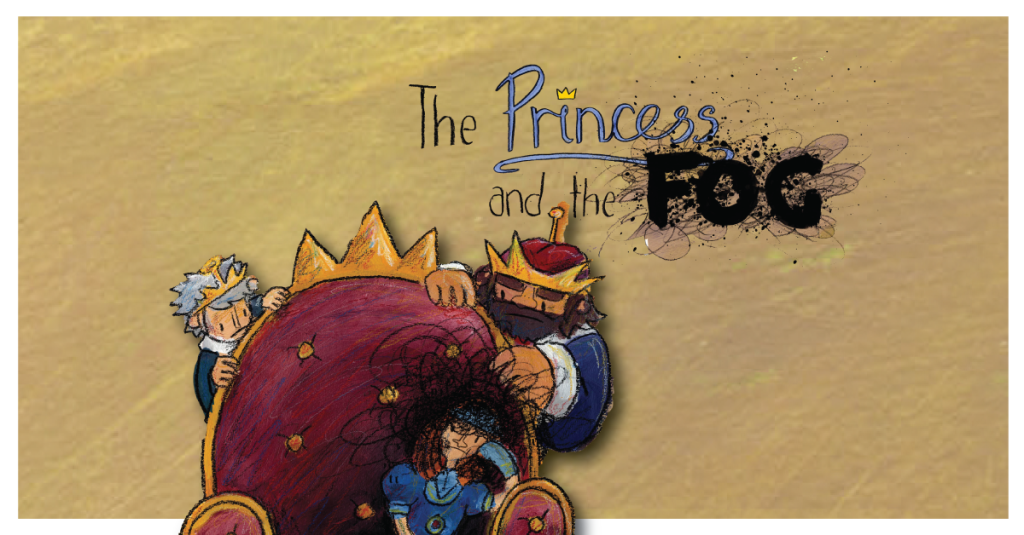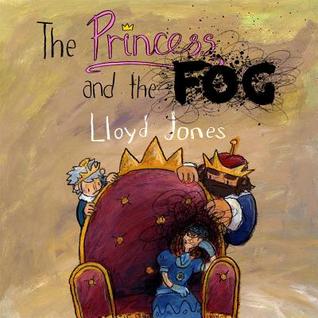It may be hard to believe that children can experience depression at a very young age, but as the NHS explains, “10% of children in Great Britain aged between 5 and 16 have a mental health problem, with 4% of children suffering from an emotional disorder such as anxiety or depression.” Lloyd Jones, author of The Princess and the Fog, shares his personal experience with depression as a child and adult, and explains how he learned to cope through his art.
This content was originally posted on Lloyd’s blog.

‘Depression has been something of a running theme in my illustration work for a long time and The Princess and the Fog is obviously no exception. It is a subject that is very near and dear to my heart as I’ve personally suffered from depression for most of my life.
I first felt as though I had a tendency towards depression when I was a child. I had only a cursory understanding of what it was – namely that it made you feel tired and sad and disinterested in things much of the time – which I felt described me, but I didn’t really know what it MEANT to be depressed or what one was supposed to do about it. I remember I confided in an adult – a family member, I won’t say whom – for some advice. “I think I’m depressed,” I admitted. “What have you got to be depressed about?” they replied, fairly astounded. And that was the end of the discussion. I suddenly felt as though I hadn’t earned the right to be depressed. I was just a kid. I didn’t have anything to be depressed about. I suddenly felt so embarrassed and so intensely alone. I don’t really remember what happened after that but I know that for a long time I wasn’t able to talk to anybody about it again.
It wasn’t until I was 21, in the second year of my BA, that I was first officially diagnosed with depression and put on fluoxetine. Suddenly I was allowed to be depressed. It was okay to talk about it and there were pamphlets and medicines and all sorts of things I was allowed to know about. I had had some experiences in college with herbal remedies and counselling that only seemed to be taken semi-seriously and didn’t really do much for me but this was the real deal. Depression as a theme started seeping into my illustration work as something I finally understood enough to be able to communicate. Projects like the Short Term Diaries of the first year of my MA gained some popularity as an alternative therapeutic tool, and I seemed to reach a lot of people with my short graphic memoir zine There’s A Hole In My Chest and its follow-up There’s a Hole In Your Chest. I was meeting and communicating to increasingly more people who felt the way I did.

For the second year of my MA I wanted to do something different, having felt a bit stifled by the Short Term Diaries towards the end of the project. I liked the responses I got to my Hole in Chest books so I thought it might be a good idea to keep the same theme rolling. Writing and illustrating a picture book had been on my bucket list for a while so I thought I’d give it a try.
When I began writing the story I had to do a lot of research into childhood depression to make sure I tackled the subject responsibly and respectfully, and to make sure I got my facts straight. I discovered after struggling to find much that childhood depression was still a relatively new concept and that up until recently it was believed that children could not become depressed. Suddenly I had a bit more context for the loneliness I had felt as a child. There were hardly any books for children with depression out there. There were dozens of books and pamphlets and cartoons and other media for children living with just about any other mental illness you could think of, but not depression. I realised that if I made one, it could actually be really important to someone. A year and a half of working on it later, and here we are.
If I had had a book like The Princess and the Fog when I was a child, I wonder how different things would have been. If I’d known that I wasn’t the only person out there feeling this way, I can’t help but think I might have felt a lot less isolated and desperate, and perhaps because of that I would have had a better understanding of how to deal with it. That was the book I tried to create. If The Princess and the Fog helps even one kid out there feel like they don’t need an excuse to be depressed, that there’s somebody else out there who’s been through the same thing and survived, and that they can do the same, then I’ll have done my job and I’ll be happy.
Lloyd Jones lives in the south of England. Lloyd has a first class honours degree in Illustration from the University of Portsmouth, an MA in Sequential Design and Illustration from the University of Brighton and he is currently working on a PGCE FE from the University of Southampton. He has learned to live with his fog, rather than suffer from it. Learn more about The Princess and the Fog.
Find out more about depression and anxiety in children here.
Goodreads Book Giveaway
The Princess and the Fog
by Lloyd Jones
Giveaway ends August 19, 2015.
See the giveaway details
at Goodreads.

I had my first depressive episode at six years old. It was very scary and no one understood. By 13, I had run away from school, was put on tranquilizers, and at 14, I had made a half-arsed suicide attempt. It’s a lot more common than people want to believe and getting worse. I’m in my late forties now, and it’s pretty much treatment resistant now.
Depression can incorporate sentiments of uselessness, powerlessness to focus, uncertainty, touchiness and bigotry of others, absence of inspiration or interest and withdrawal.
Thanks for sharing such a good blog.